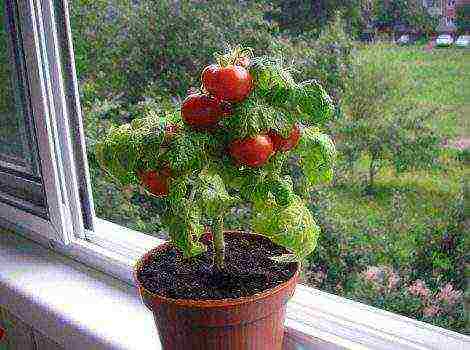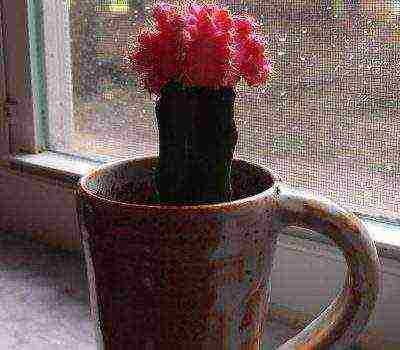Content
4 methods: Prepare the container Plant the seeds Take care of the seedlings Transplant the flowers
Growing flowers from seeds can be a daunting task for novice gardeners. Seeds and sprouts are very fragile and can easily be destroyed by improper conditions. For the best results possible, sow seeds indoors in a small sterile container using a special potting soil mixture. Follow the directions on the seed package and provide the sprouts with plenty of light and water. When the roots are strong enough, transplant the flower seedlings outdoors in your garden.
Method 1 Prepare the container
-

Select a container. You have a variety of inexpensive options to choose from. Seedling containers or cassettes are cheap and designed specifically for germinating seeds. However, plastic cups and egg cartons are also suitable and economical containers. Small flower pots can also be used.
-

Make sure there is enough room in the container for the seeds to germinate. Better if it is at least 10 cm deep. This will allow the root flower system to develop.
-
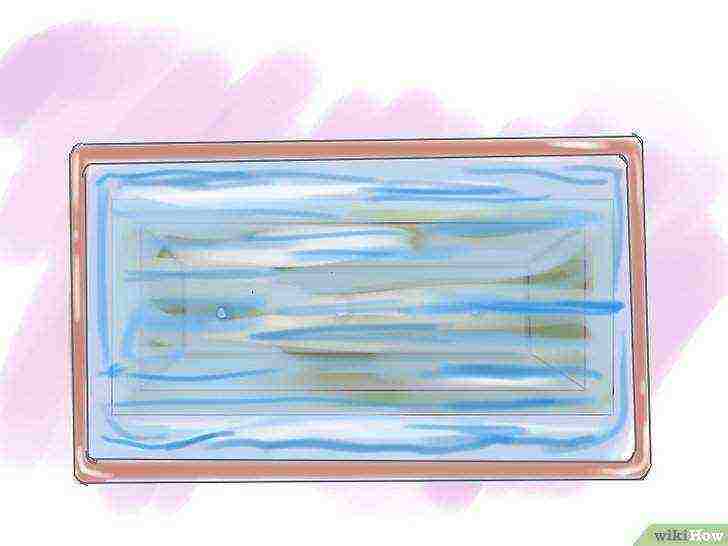
Sterilize the container. If you are using an old plastic pot or pallet, fill it with a solution of 1 part lime to 9 parts water and rinse thoroughly. If the container is new, it is not necessary to sterilize it.
-

Provide adequate drainage. Most plastic pots and seedling trays already have water holes. If you take a plastic cup, egg carton or other non-special container, then before filling the soil, make a small hole in the bottom.
Method 2 Plant the seeds
-
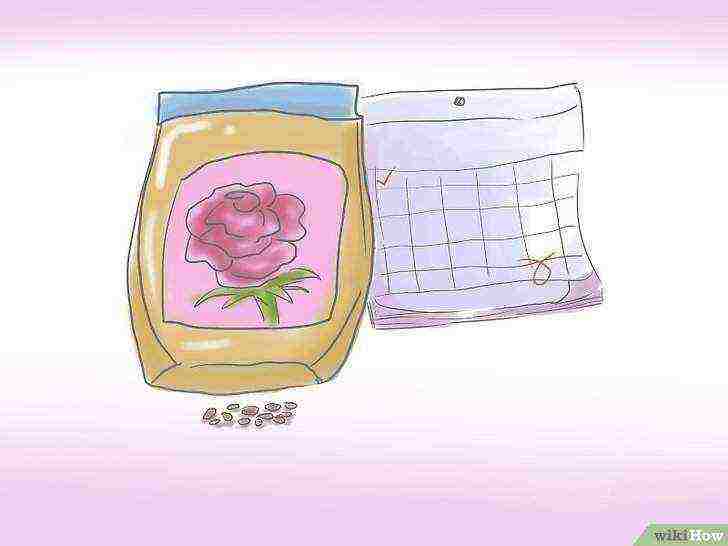
Start germinating seeds indoors 4-8 weeks before you plan to transplant your plants outdoors. This usually means 4-8 weeks before the last expected frost. This will give the seedlings enough time to mature and not be afraid of wind, insects and other pests.
-
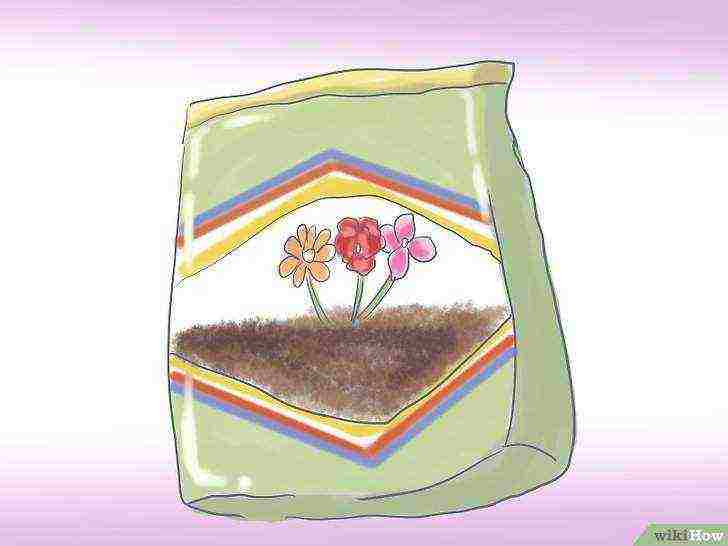
Choose a soil. Peat tablets are convenient to use in seedling trays, but a larger container will require good soil. Buy packaged soil from a gardening store to ensure high quality and sterility. Often on the market you can find a special mixture for growing seedlings.
-
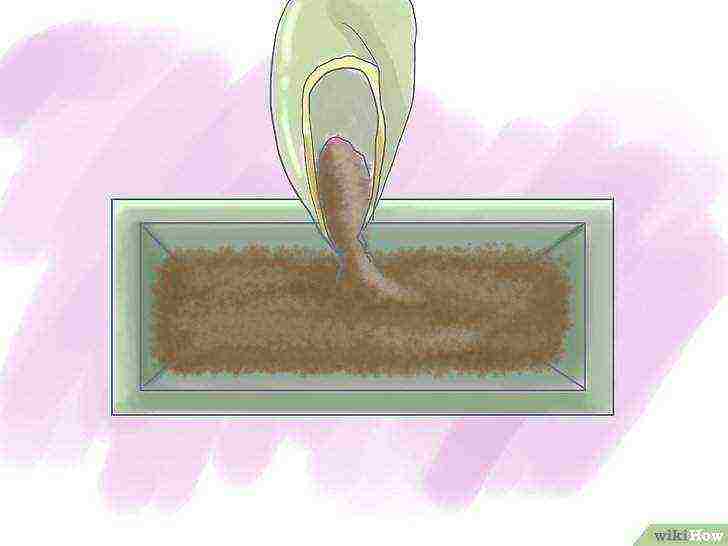
Fill the container three quarters with soil. Do not compact the ground - keep it loose.
-
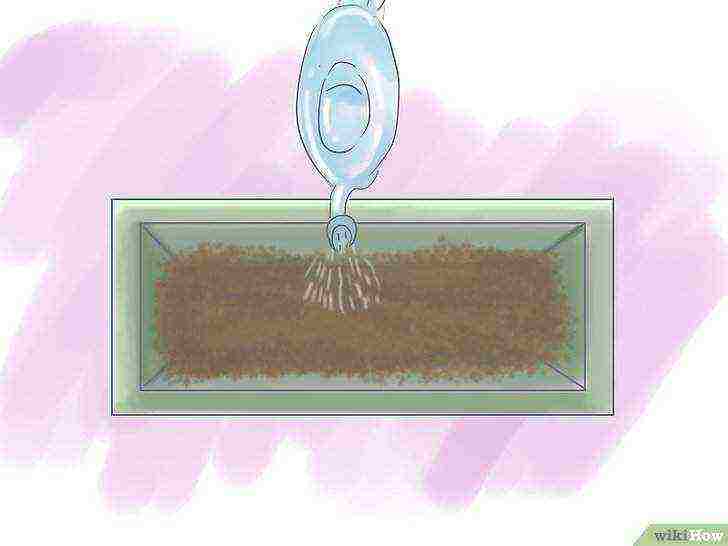
Moisten the soil before planting seeds. Add water to keep the ground well hydrated, but not completely wet.
-
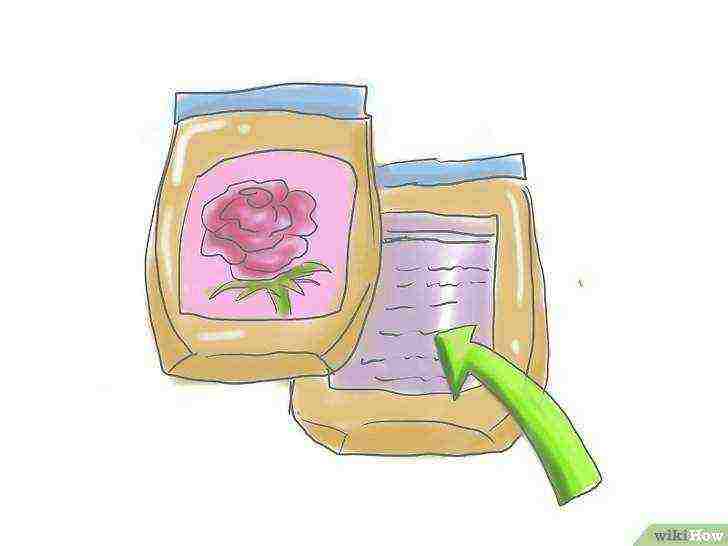
Follow the directions on the seed bag when planting. The seeds of some flowers need to be covered with a layer of soil up to 2.5 cm, while others, small seeds just need to be scattered over the surface of the ground. In any case, do not tamp the soil over the seeds, otherwise they will "suffocate" and it will be difficult for the sprouts to break through to the surface.
-
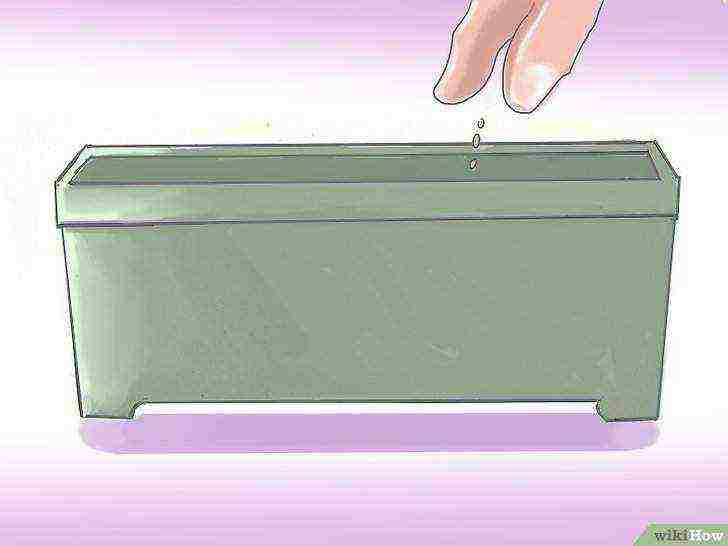
Plant two or three seeds in each small container or cassette. Leave a distance of about 6 mm between them so that if all the seeds germinate, they do not interfere with each other.
-
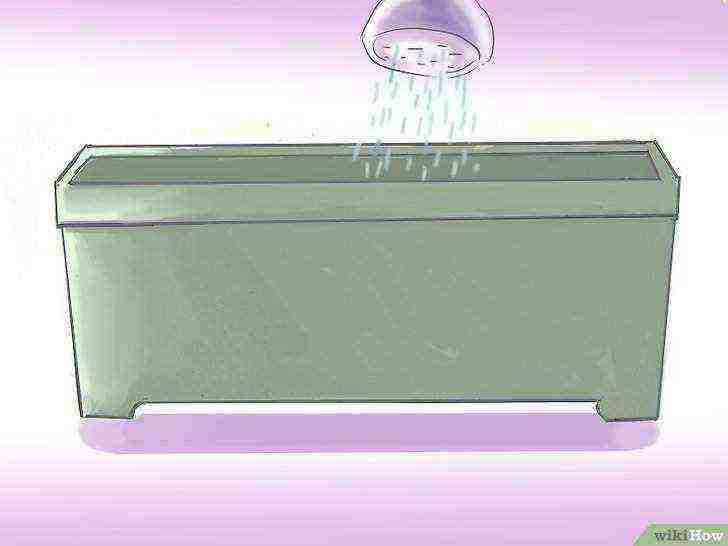
Water again. Throw in just a little water to moisten the seeds and newly added soil. Do not add seeds.
-
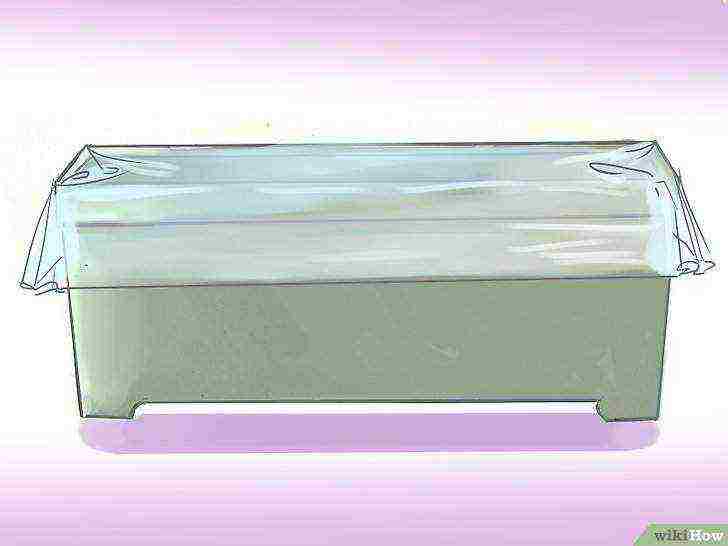
Cover the container. If you are using a special one, it may come with a clear plastic cover. If not, use a clear plastic wrap. The seeds should be covered to keep them from drying out, but the cover should allow sunlight to pass through.
Method 3 Take care of the seedlings
-
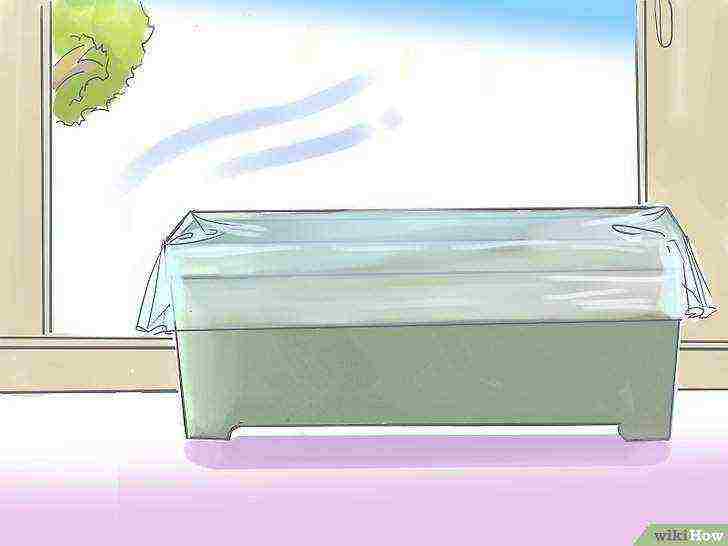
Place the seed container in a draft-free location. However, it must be well ventilated. If you want to create air circulation, turn on an electric fan in the room, placing it close, but not pointing directly at the container. Run the fan for just a few minutes each time.
-

Follow the directions on the seed package for temperature and sunlight. Usually, it is recommended to place the seeds near a window, but not in direct sunlight.
-
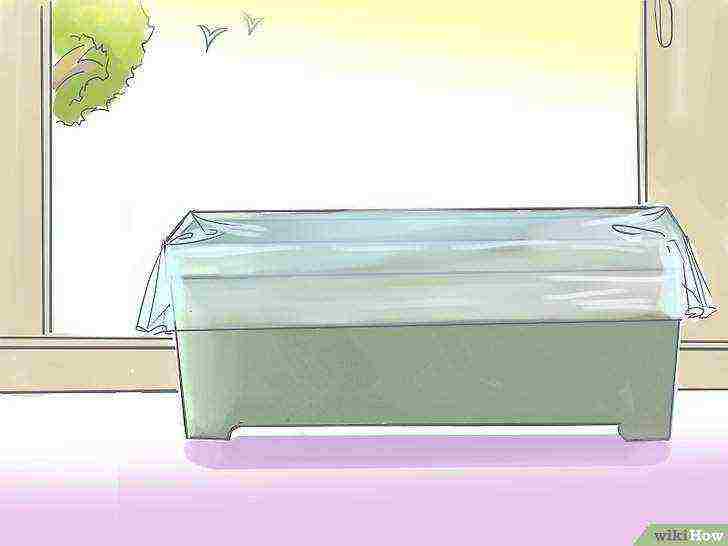
Provide additional lighting if necessary. Some sprouts require up to 16 hours of light per day to develop normally. If this is the case in your case, during hours when there is no sun, illuminate the seedlings with a fluorescent lamp, fixing it at a short distance from the uppermost leaves.
-
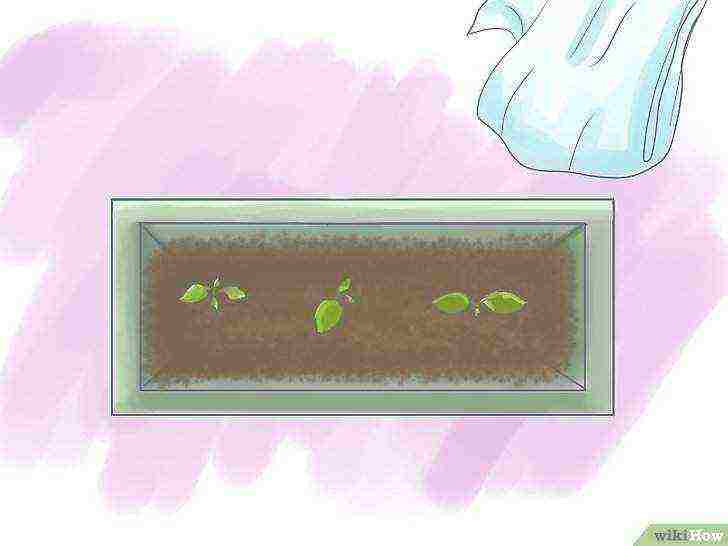
Remove the lid or film when the sprouts produce two pairs of leaves. Move the seedlings to a lighter area.
-
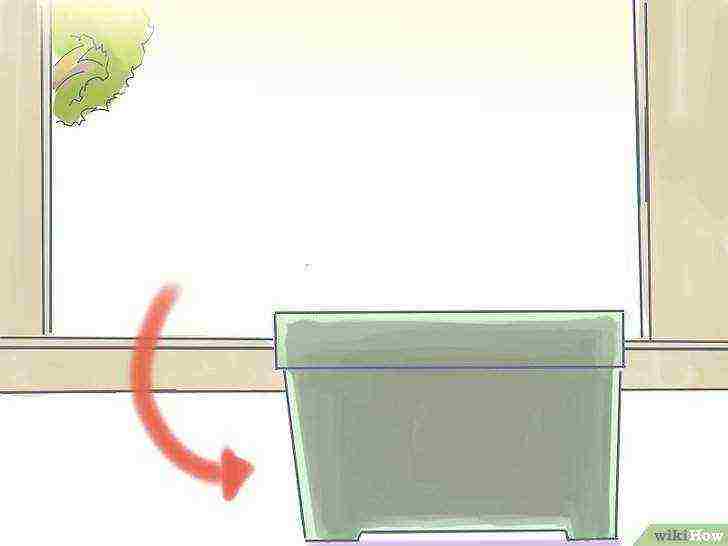
Rotate the container every two or three days. Otherwise, the entire seedling will tilt to one side, as it will reach for the light.
-
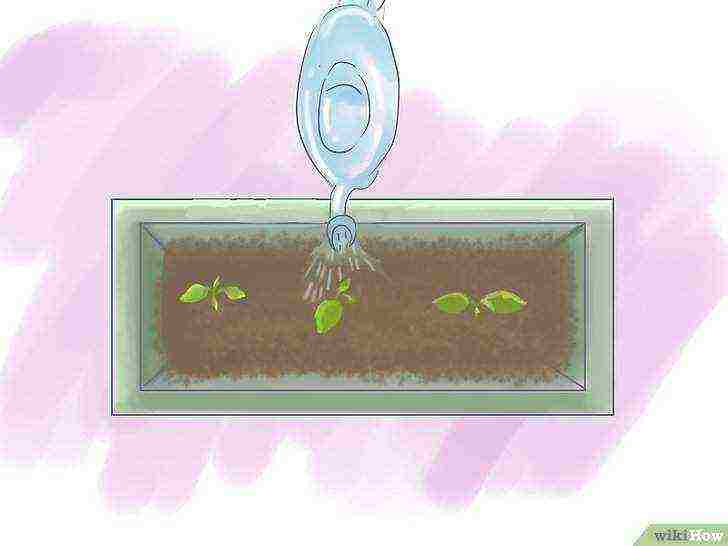
Water the seedlings by gently spraying water rather than using a strong stream. Use a spray bottle whenever possible. Gentle watering will prevent damage to the fragile, still developing root system.
-
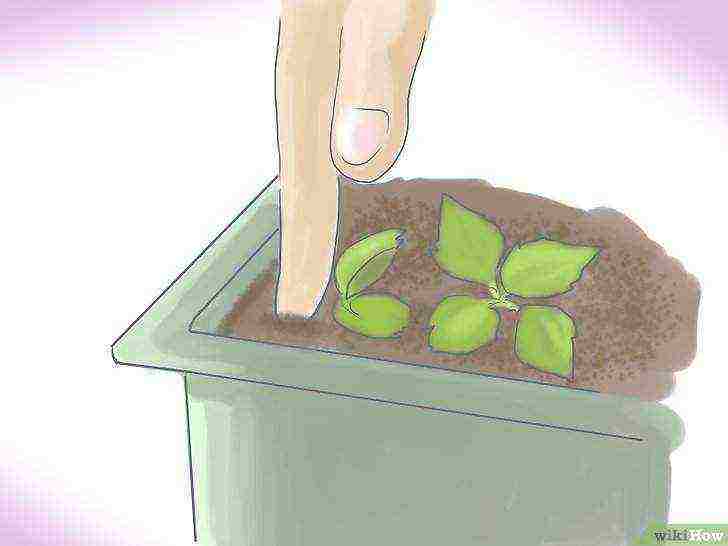
Use your finger to check the ground to see if watering is needed. If you touch the soil with your finger and feel moisture, you should wait with watering. Keep the ground moist, but not wet.
-
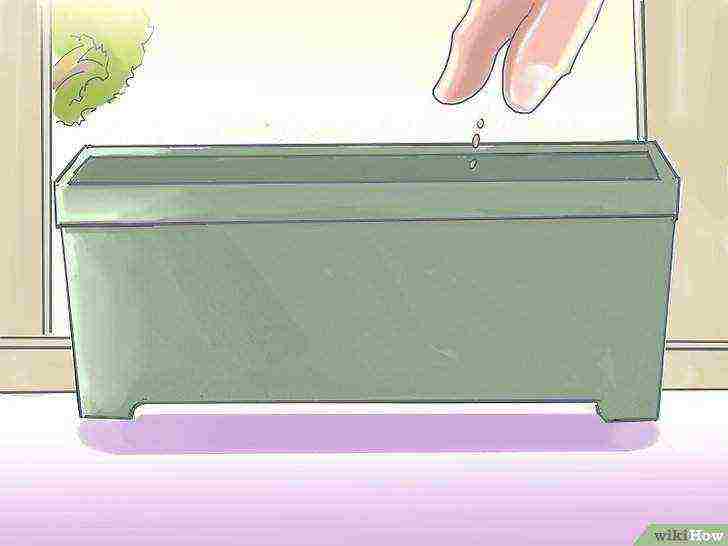
When the sprout has a few leaves, add fertilizer if desired. Use a not very strong fertilizer - it is advisable to buy a special one for young shoots.
Method 4 Transplant flowers
-
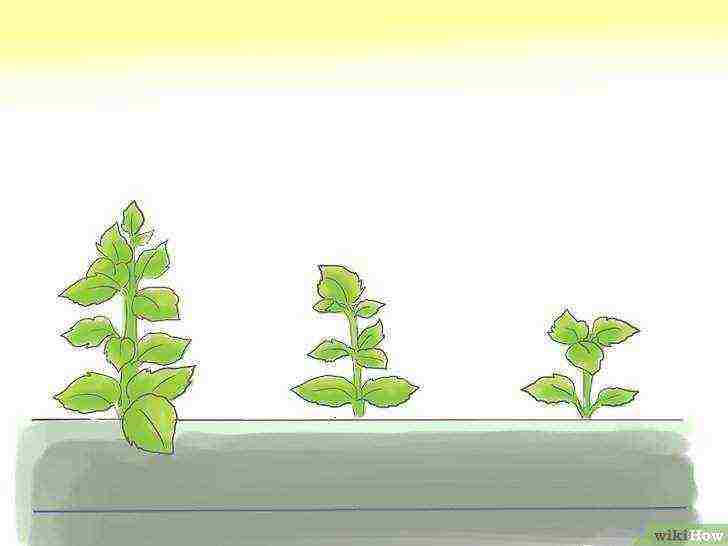
Let the seedlings grow strong before replanting. Leave the container in full sun and outdoors for several days. Water the seedlings and protect from the wind. Bring the plants indoors at night, especially if the nights are still cold.
-

Dig a hole in your garden twice as deep as your pot. Fill half of the loose soil back so that the depth is equal to the container. The point of digging up the soil and filling it up again is to provide a loose enough soil in which the flower roots can take root.
-
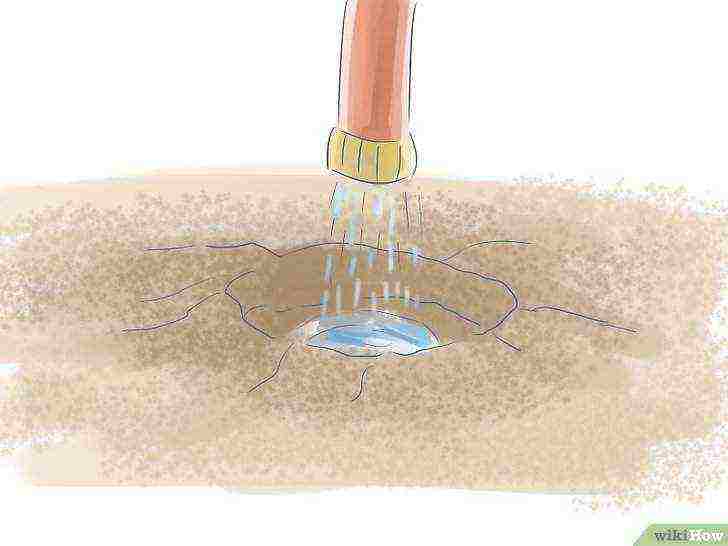
Water the hole. Do not completely fill it with water, but moisten the soil well.
-
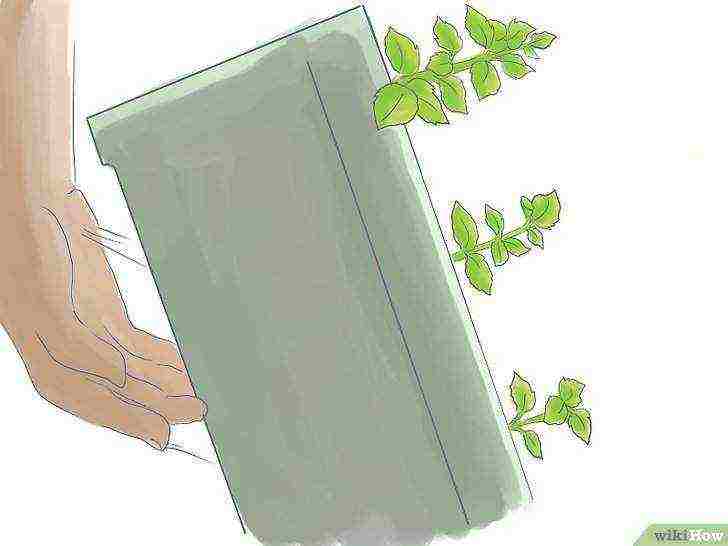
Tilt the plant pot on its side. Tap the bottom and sides lightly until the earthy ball is pulled out of the container without effort.
-
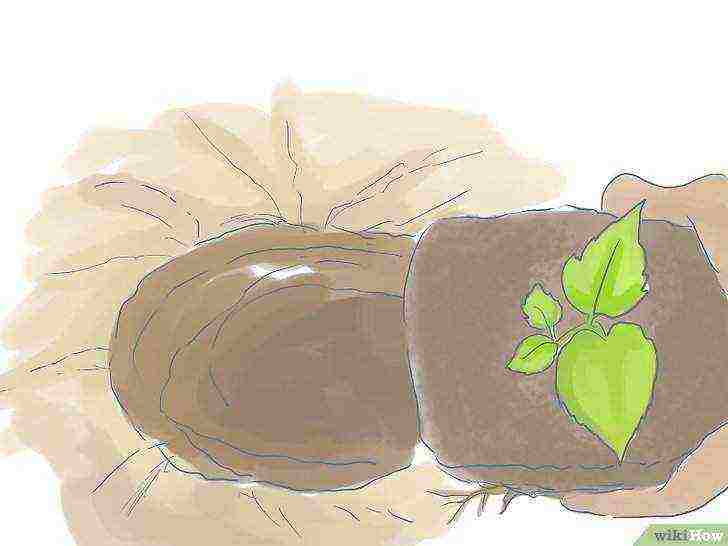
Place the plant in the hole. The root system must be sufficiently developed, then the roots, together with the soil, will retain the shape of the container.
-

While holding the plant with one hand, fill the hole with earth to the end with the other. Make sure the plant sits firmly in the soil, but don't tamp it too tightly.
-

Water some more. Don't flood the flower, but make sure the ground is moist.
Tips
- If you want to grow simple annual flowers that can be planted directly in open ground, choose sunflowers, marigolds, morning glory, cornflowers, calendula, castor oil plant (be careful, the plant is poisonous!), Cosmea, nasturtium, sweet peas, fragrant alissum, delphinium, poppies, zinnias or hyacinth beans (lobia).
- If you want simple perennial flowers that are planted indoors and then transplanted, try planting rudbeckia, catnip, perennial geranium, valerian, asters, echinacea purpurea, armeria, yaskolka, or yarrow.
- Repot the flowers when the roots reach the bottom of the container. This usually happens when the plant already has three pairs of leaves.
- If you want to plant relatively simple annuals that need to be grown indoors, try glue, coleus, snapdragon, ageratum, amaranth, scented tobacco, hatyma (lavatera), petunia, balsam, sage, or kermek.
What do you need
- Seeds
- Seedling container (cassette)
- Egg carton
- A plastic cup
- Small pot
- Bottle for water
- Fluorescent lamp
Article Information
This page has been viewed 4,217 times.
Was this helpful?
A beautiful flower garden can become a "highlight" of any country house or cozy summer cottage, so you should also take care of flower seedlings in advance, choosing the desired varieties for seedlings, distributing them according to the sowing dates, preparing the soil and containers. The seeds can be bought at a specialized store or you can take care of their preparation yourself. To do this, at the end of the growing season, you need to collect the seeds in the buds and store them in a dry and warm place. For exfoliation, fabric bags or gauze are used: dried buds are put inside and rubbed, and then sifted through a sieve.
Depending on the flowering period of the species, the collection of planting material can be done at any time, but most often from August to October. Before sowing, from procedures, it is necessary to carry out stratification, disinfection and hardening of seeds. For even seedlings, heat treatment is possible, re-hardening of seedlings and seedlings (except for lavender) is not recommended, since the flowers are heat-loving plants and may die.
Growing flowers from seeds at home
Almost all ornamental plants love high humidity and long daylight hours, so before growing flower seeds for seedlings, prepare a place on the veranda or windowsill. Drip irrigation is ideal until 2-3 leaves appear, then regular spraying in the morning and evening. Until the first shoots, during the "black earth" period, the seedlings should be kept under a film or cover.
How to grow petunia from seeds
Sow petunia in small containers on a closed balcony, or on a windowsill in a room, at the end of winter. They are very small and require shallow sowing, which often causes some difficulties for growers.
Seedling petunia
The main secret of success lies in maintaining the optimum air temperature (20-22 degrees) and moderate soil moisture for germination and successful rooting of seedlings. In such conditions, the first shoots appear on the 5-7th day. We dive young seedlings into a separate container when they get stronger.
How to grow lavender from seeds
For lavender, south-facing windowsills are ideal. You will need a short, wide pot, good drainage, and an alkaline potting soil.
The first sprouts from lavender seeds
For good germination, lavender needs a little stress: immediately after planting, the container is placed in the refrigerator for re-hardening, previously covered with a film. With the appearance of the first shoots, lavender needs good lighting, in order to avoid stretching the seedlings, it is advisable to provide it with additional lighting. The grown plants need regular watering - in the morning and in the evening, as well as gradual accustoming to the humidity and air temperature in the room where it will grow.
How to grow a rose from seeds
Most often, roses are propagated by cuttings, but with the help of seeds taken from donated bouquets, you can decorate your garden with really rare specimens. Before sowing, a well-dried material should be soaked in Kornevin's solution and kept for a day at a low temperature.
Sowing rose seeds for seedlings
Seeds should be germinated on a damp cloth. The first seedlings can be seen after 1.5-2 months, after which they are transplanted into peat pots or another container.Young rose sprouts need drip irrigation and long daylight hours: use artificial light sources and automatic irrigation systems.
How to grow an orchid from seeds
Orchid family members are capricious and unable to germinate in a normal environment. Their seeds are microscopic and do not have their own food reserves, which is why it is so difficult to provide them with suitable conditions.
For germination, you will need a special hydrogel, which will be the basis of the substrate. Seeds sterilized with a solution of calcium hydrochloride (10 mg per 100 ml of water) are placed in it.
Orchid seedlings in hydrogel
At a temperature of 18-22 degrees in the room, and sufficient lighting (13-15 hours), the emergence of seedlings can take from a week to several months. In the future, traditional soil is used for orchid seedlings: well-soaked moss or finely chopped pine bark.
Outcome
Knowing how to prepare and grow flower seeds for seedlings for germination, you can prepare in advance by purchasing everything you need. And having prepared the seed material from the donated bouquets, decorate your site with beautiful and unusual plants.
Plants make our home more comfortable and beautiful. Someone chooses the easier way and buys flowers in the store, while someone stops at the more laborious growing of indoor plants from seeds. Consider what flowers can be grown in this way at home.
Features of growing at home
Sowing of most indoor flowers is carried out in the spring. The favorable period for planting is usually indicated on the seed package.
When choosing a pot from under another plant, do not forget to process the container
What kind containers are suitable for sowing:
- plastic or polystyrene pots;
- clay pots;
- boxes with square or round cells of different sizes;
- peat cups for seedlings.
If you use containers that were already in use, they should be well treated with soda solution and soap before planting. This is necessary, since tender seedlings can become infected with various fungal diseases (rot, mold).
In any container, before planting at the bottom, you must do hole for draining excess moisture.
The choice of soil is at your discretion. You can purchase a special plant mix or make your own. For cooking, mix one part of peat chips, one part of sand and two parts of sifted earth from the garden.
Before filling the container with earth, drainage should be made from pebbles, clay shards, expanded clay, polystyrene, pieces of red brick.
Next, fill the containers with soil mixture to a height of 1.5 - 2 cm from the edgepressing it down a little. Distribute the seeds evenly and not very densely from above. If the seeds are small, then they can be mixed with sand and distributed over the container.
Choose a ready-made substrate or prepare it yourself - it is not important for a flower, if all proportions are observed
We do not cover small seeds with earth, but press a little into it. Cover larger seeds with a thin layer of earthen mixture, then press down a little.
It is advisable to water with a spray bottle or a watering can with a fine "rain". Second option - for watering, place the pot in a shallow container of water for a couple of hours to moisten the soil through the drainage holes.
After watering, it is recommended to close the pot with a transparent plastic lid or glass to create a greenhouse effect. You need to place a mini-greenhouse in a well-lit, warm place.
To prevent the formation of a large amount of condensation, it is necessary to remove the glass or plastic cover for ventilation every 3-4 days.
Germination time each plant has its own: from several days to several weeks.Additional factors affecting the germination rate are seed freshness, moisture level, temperature background, timeliness of watering.
When the first sprouts appear, the lid must be removed and the container moved to a well-lit place, but not under the scorching sun.
Next stage - picking new plants into separate pots.
A pick is carried out when the first true leaves appear at the seedlings. The whole process must be carried out carefully and carefully so as not to damage the delicate sprouts.
For this:
| Step 1 | remove the plants along with the earthy clump and carefully separate their roots |
| Step 2 | holding the seedlings by their leaves, place each one in the holes in the soil in new pots |
| Step 3 | lightly press the ground around, covering the roots and water gently |
| Step 4 | as soon as the plant is well rooted and grows up, after about a year, you can transplant it into a new, more spacious pot |
What indoor flowers can be grown from seeds at home
Many indoor plants reproduce by seeds: decorative-leaved, decorative-flowering, succulents, palms.
Among decorative flowering - various varieties of begonias, cyclamen, passionflower, streptocarpus, balsam, gloxinia, abutilon, anthurium, hibiscus and even fussy orchids.
Among decorative leaf - coleus, dracaena bordered, asparagus, bokarnea, antarctic cissus, croton, coffee, cordilina.
Among palm trees - washingtonia, squat hamerops, date, Forster's hoveya, graceful hamedorea.
Exotic plants
At home, amateur flower growers often take up the cultivation of exotic plants from seeds. Of course, you will get flowers and fruits faster from a purchased flower, but they often die in an apartment.
Grown from seed are more resilient from the start.
For the successful cultivation of exotic plants, you should comply with a number of measures:
- sterility of the soil;
- preliminary preparation of seeds (soaking, treatment with microelements, bubbling, scarification, stratification);
- thermal and light conditions;
- air humidity;
- the use of growth regulators.
Among the exotics that settled on the windowsills, you can find avocado, kiwi, coffee, citrus fruits, pomegranate, figs, feijoa, dates, passion fruit. With proper care, you can achieve not only flowering plants, but also enjoy their fruits.
Do I need to process the seeds of indoor plants
Special treatment of seeds to improve their properties is usually carried out by the manufacturer. If, however, pre-treatment is required before planting, you will find the instructions on the package.
Processing options seeds:
- dense-coated seeds are sometimes recommended warm up, dipping in a very warm solution of potassium permanganate for 12-16 hours, a solution of boric acid or hydrogen peroxide for 15-20 minutes. Then you need to rinse the seeds in clean water.
- to accelerate germination, before sowing the seeds can be soak in epine, zircon, potassium, sodium (up to 12 hours).
- Stuck seeds, or hard-to-sprout seeds, can be arranged cold and hot shower: Soak in cold and hot water alternately.
- Stratification - placing the seeds in the cold, the temperature is from 2 to 5 heat. The seeds are placed on a damp cloth and placed in a bag and sent to the refrigerator for 2-3 days.
In this case, the fabric must be damp. Then we sow it into the ground. For tropical and subtropical plants, this processing method is rarely used.
- Scarification - damage to the hard shell of seeds before soaking (puncture, incision, filing with a nail file).
Indoor flowers from seeds
Orchids
Orchids have won the hearts of many people, not just avid flower growers. Phalaenopsis, Vandu, Cymbidium, Dendrobium, Zygopatelum can add to your collection and can be grown from seeds.
Initially, we prepare the inventory (flasks) by calcining it in the oven at a high temperature. This is followed by sterilization:
| Sterilization Is a major step in growing orchids that should not be overlooked. | priming | can be sterilized in the oven |
| the seeds | disinfected before sowing by dipping them into a filtered calcium hypochlorite solution for 10 minutes |
You can sow orchid seeds "over steam": a grate is placed over a pot of boiling water, a flask with soil is placed on it. With a pipette, seeds are taken from the solution and transferred to the substrate. At the same time, we act quickly.
Next, the flask must be closed with a swab and put on germination. The temperature regime must be maintained from 18 to 23 degrees Celsius. Light mode - from 12 to 14 hours (daylight, if necessary - additional illumination with lamps).
The backlight for flowers can be assembled at home by yourself
Orchid sprouts develop slowly. You need to be patient and after about 3-4 years they will delight you with the first flowers. We described everything in more detail in the article on orchid flowering at home.
Salvia
Salvia is a perennial plant. When grown in a flower bed - annual or biennial.
Can be grown indoors from seeds or granules. The granules germinate more slowly.
Sowing seeds is carried out from mid-February to early March in moist, loose soil superficially or to a depth of 2 mm. Temperature regime - 25 ° C. Seedlings appear within 2-4 weeks.
The pick is made twice.... After the appearance of the third or fourth leaf, the seedlings are pinched to form a beautiful bush.
Dracaena bordered
Dracaena can decorate any room, which is why they are so popular. If you are fortunate enough to have purchased plant seeds from a store, you can try growing them.
The process is enough long and laborious, germination can last up to six months. Unfortunately, not all seeds germinate.
If you want to grow dracaena from seeds, you have to be patient.
Stages of growing dracaena from seeds:
- Place the seeds in a little water. Cover with a cloth and place in a dark, warm place.
- Sprouted seeds plant one at a time in a container with drainage and soil for dracaena to a depth of 1 cm. Sprinkle with earth. Spray with water using a spray bottle.
- Cover the container with a flower with foil or glass and place it in a warm place to germinate. Ventilate and water periodically.
- When will the sprouts appear and grow up to several centimeters, remove the film and place the plants in a warm, bright place.
A detailed description of the flower (also known as marginata) can be found in the section on dracaena varieties.
Peony roses
Peony roses appeared at the end of the 20th century... It is a hybrid plant whose official name is Austin roses.
The propagation of roses by seeds is theoretically possible, but it is rarely carried out, since it takes more than one year to grow them.
The main problem in growing roses from seeds is unpredictable result... Flowers on new bushes differ from their parents almost completely.
It is better to propagate peony roses using cuttings, layering. But for the purpose of experiment, you can try to grow flowers from seeds:
| Training | First, the seeds must be placed in a cold and humid place for several months. |
| Sowing | After about 2 months, they need to be sown in a pot with nutritious soil and sand. |
| Layout | Seeds are spread on the surface, sprayed with a spray bottle. You can sprinkle a little with sand |
| Result | Sprouts should appear in a month |
We described other points related to reproduction in the article on planting and breeding peony roses.
Asparagus Sprenger
Asparagus Sprenger is often found in the homes of florists. It is not difficult to grow a flower from seeds.
March and april the most favorable months for planting a plant. Before planting, it is advisable to soak the seeds for 2 days in a damp cloth. Next, we sow in a slightly moist soil mixture of peat and river sand.
We do not deepen the seeds, sprinkle a little with soil on top.
When watering, keep in mind that the seeds can be washed out due to a slight deepening
Cover the container with foil or glass. We ventilate and spray daily. Seedlings should be expected after a month. We carry out a pick with sprouts of 8-10 cm. After 4 months we transplant into a more spacious pot.
We presented the description and photos of the plant in a separate section on the Ethiopian asparagus (Sprenger).
Gloriosa Rothschild
Gloriosa Rothschild is often propagated with tubers. To grow it from seeds, you need to be patient.
Seeds quickly lose their germination and should be plant immediately after harvest... The soil mixture should consist of peat, turf and sand in equal proportions. It is necessary to sow seeds in late autumn - early winter.
The temperature regime should correspond to 20-24 degrees Celsius. The soil must be moist, not allowed to dry out.
Seedlings should be expected after 1.5 - 2 months, or even later. Next, you should very carefully thin out the strengthened seedlings.
Next stage - seating in separate pots. Gloriosa can be expected to bloom in about 3 years.
Gloriosa is a very unusual and beautiful plant for the home
Nolina (bokarney)
Nolina, or bokarney, is an ornamental-leaved plant with an unusual trunk shape - a bottle (for this reason, it is also called the "bottle tree"). Nolin is propagated by cuttings and seeds.
Stages of growing nolina from seeds:
- Soaking the seeds in a light solution of salt or potassium permanganate for a day. Swollen full seeds go down, "empty" - float up.
- We use drowned full seeds for planting.
- Sowing is done into a sand-peat mixture... Before use, the soil must be steamed for 30 minutes. You can add vermiculite to the soil mixture.
- The pot should have a hole for draining excess moisture, drainage.
The optimal light regime for germination is 14-16 hours (at least 12).
- Seeds we sit down superficially, slightly pressing down with a board.
- On top of the pots you need to cover with foil or glass, when shoots appear - remove.
- Temperature range - 22-27 ° C.
- After the formation of three true leaves, we dive the seedlings into separate shallow pots with drainage.
It is interesting that at home a flower does not grow taller than 2.5 meters, while in the wild, the height can reach 8 meters. Nolina's appearance and general care points can be found in the section on growing bokarnei at home.
The choice of plants for growing from seeds is a responsible process, since each variety has its own requirements.
The process of growing indoor flowers from seeds at home is sometimes quite laborious and painstaking. But, as a result, a new plant will appear in your house, grown by your own hands.
Added on 03/02/2011 spring, planting, seedlings, seeds
 Most flowers reproduce well by seed. And this is not at all difficult if you know and follow some simple rules, little tricks and characteristics.
Most flowers reproduce well by seed. And this is not at all difficult if you know and follow some simple rules, little tricks and characteristics.
Annuals
An extensive group of plants loved by many gardeners. Annual plants brighten and liven up the garden. You can form flower beds exclusively from annuals; they are often used in mixed plantings with perennial plants.
Annual flowers from seeds are grown both outdoors and in greenhouses. Annuals are usually sown in open ground, which do not tolerate transplanting well, as well as those in which seeds quickly sprout. Annuals are sown for seedlings at home when they want to achieve their early flowering, as well as plants that have a long growing season. Sowing advice is usually indicated on the seed package.
Summer plants for seedlings
If the seedlings of flowers are grown at home, it is necessary to prepare in advance fertile soil and containers for planting (boxes, pots or containers). Some annuals are sown already in winter - in January or February (for example, Shabo carnation, ever-flowering begonia, balsam, heliotrope, pelargonium, eustoma and some other "slow-witted" flowers). However, more often sowing is carried out at the beginning of March (for example, various petunias, snapdragons, lobelia, annual aster, godetia and many others are sown in this way).
Special conditions for some annuals:
| Sowing and germination conditions | Plants |
| Surface sowing (do not cover with soil) | Ageratum, petunia, lobelia, purslane. ever-flowering begonia, snapdragon, primrose, mimulus, bell. |
| Germinating in the dark | Verbena, schizanthus, annual phlox (Drummond), salpiglossis. |
| Germination in the light | Petunia, lobelia, coleus, purslane. ageratum, snapdragon. |
Sowing letnikov in open ground
The timing of sowing annual flowers in open ground is also different. Plants that are resistant to light frosts (for example, mignonette, calendula, early varieties of sweet peas) are sown in early spring. Heat-loving flowers (such as nasturtiums, marigolds, zinnias, cosmeas) are sown from mid-May. In May, grown-up seedlings of annuals are usually planted in a permanent place.
Biennials
Plants of this group do not bloom in the first year; they produce only leaves, often collected in a compact outlet. Flowers appear on them only in the second year; after flowering, such plants die off.
Sowing of biennials can be carried out at different times, but most often they are sown directly into the ground in the middle of summer. Some biennial species can be sown in the spring (such as daisies, forget-me-nots, and viola). In this case, they will bloom for the first time by autumn; but in full force their flowering can be admired only in the next season.
Biennials are sometimes grown as an annual crop. In this case, sowing for seedlings is carried out in February in protected ground. In this way, for example, flowering viols are obtained in the first year.
Perennials
Perennial plants grow in one place for several years and annually delight with their flowering. Sowing of perennials is carried out almost all year round, both in open and in protected ground.
Most perennials reproduce by spring sowing. In March - April, for example, delphiniums, loosestrife, various decorative bows and other plants are sown in open ground. In April - May, it is time to sow perennial carnations, geraniums, host.
In summer, in July - August, perennials are sown, which quickly lose seed germination. These are lumbago fading in spring, marigolds, muscari and others. In late autumn, perennial asters, daylilies, primroses, aconites are sown, as well as slowly germinating seeds of irises, fragrant violets, adonis and some other flowers.
You can grow perennials and seedlings; sowing for seedlings is carried out in January - February in fertile soil at home. In spring, young plants are planted in a permanent place in the garden. So you can grow, for example, primroses.
Little tricks
- The seeds of many plants require stratification to germinate. This is the effect on seeds of low (including negative) temperatures. The duration of stratification, as well as its technology, are different for different plant species. Sometimes the effect of natural stratification is achieved by podzimny sowing, receiving friendly shoots in the spring.
- In some plants (for example, phloxes, aconites, peonies), the stratification period lasts from several months to one year. Others are stratified for three to four weeks (such as asters, delphiniums, snapdragons) or less.
- In order not to injure the seedlings by transplanting, the seedlings can be grown in peat pots, from which the plants are not removed during planting.If sowing is carried out in boxes, grown seedlings require picking or thinning.
- Some types of seeds germinate in the light. They are scattered over the surface of the soil and lightly crushed or rolled. Crops are sprayed with water from a spray bottle, and the seed box is usually covered with glass.
Having carefully studied the recommendations for the pre-sowing preparation of seeds and growing the plant you like and following them, you will certainly achieve success when propagating flowers by seeds.
Marina Gerasimova
You may be interested in the articles:
Hydrogel secrets
Do you need "your" seeds?
We buy seedlings wisely
Peat tablets - simplicity and convenience!
Gardener's calendar

